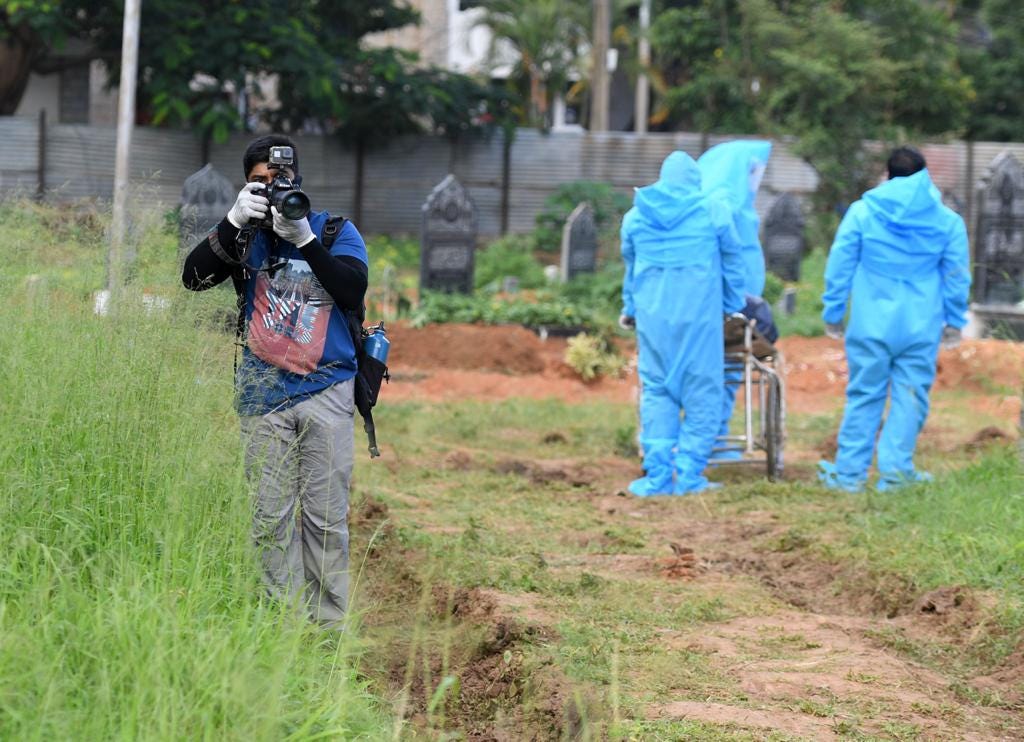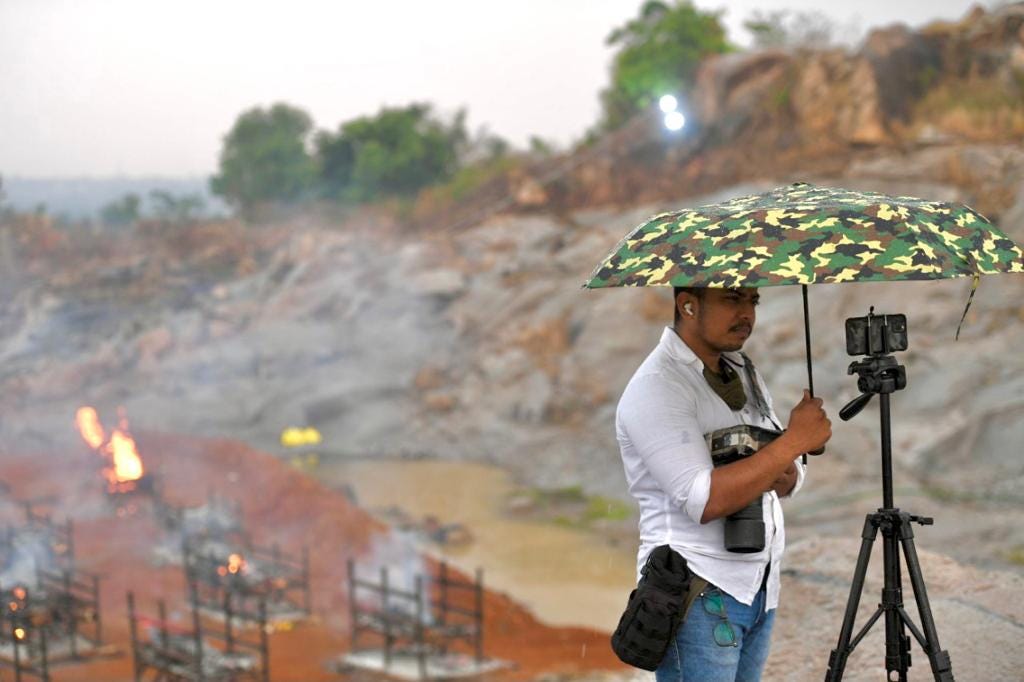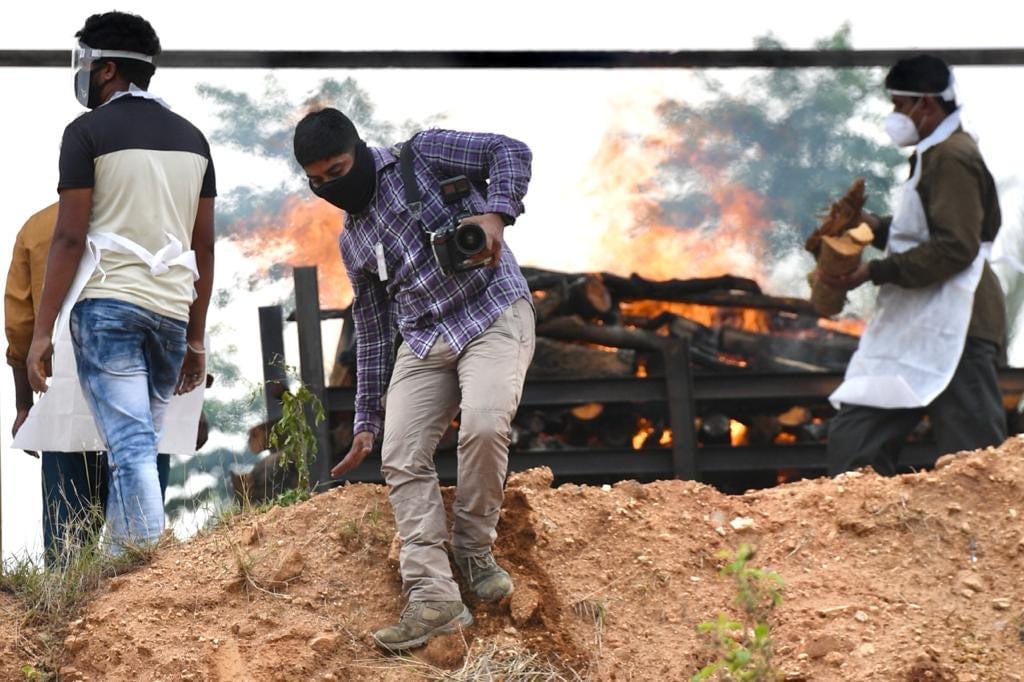Story: Barkha Kumari
Photos courtesy: Kaushik JNTrigger warning: This story talks about witnessing death, going through trauma during the Covid-19 pandemic.
“The pandemic has been the toughest assignment of my career,” admits Kaushik JN, a senior photojournalist with the Indian newspaper, Bangalore Mirror. He says this many times over to debunk the myth that people working in the newsrooms are unaffected by tragedies and that’s why they can work in the thick of it all. “Last year, 20 people wore PPEs just to bury one body and that was disturbing to shoot. But now, I see at least 20 dead bodies at any given point. So, I don’t know what I am going to witness tomorrow,” he explains why it’s impossible to be mentally prepared to cover this crisis, no matter your experience.
Kaushik has been a photojournalist for close to 15 years. He has covered crime, protests and everything in between but nothing has caused him a burnout like the second coming of the pandemic. Hundreds of cremation pyres burning together. Ambulances running all day. Patients gasping for oxygen. Families making frantic calls for ICU beds. Doctors breaking down...these visuals from the second wave of the Coronavirus in India are every bit disturbing, even if you are watching them from a distance and the safety of your home and screens. Then how do photojournalists stand this spectre, going from hospital wards to crematoria and bus stands, as they do sometimes, all in a day and have been doing it for more than a year now?
“In this one burial ground, I saw nine to 10 people bring in a heavy body and a guy crying ‘Amma’ [mother] over and over, and loudly. I saw another son lose his mom in a gap of three hours. I broke down. I went to a corner, kept my camera aside and sat there for 30-40 minutes till someone came and asked me if I was doing fine. I said, ‘No, sir. I don’t want to witness this. I don’t want anybody to witness this’.” And yet, another time, he witnessed a man standing in the middle of the road, looking distraught as his mother passed away inside the ambulance despite the availability of oxygen. Another day, he was told over a call that an old man on oxygen support who he had photographed is no more.

His anxiety is understandable. He stays with his parents and wife, so the risk of carrying the virus home, despite the masking and other measures he takes, is there. “My colleague and I made 15 calls to an ambulance for a man but by the time we could get any help, he passed away. One day we won’t be able to help ourselves (and our families),” he rues.
“I am tired of being angry, being sad, going to COVID ward rooms,” the 32-year-old sums up his state of mind. And there aren’t many he can vent his frustration to. Colleagues are there but only over a call and that’s not as good as an in-person, heart-to-heart talk. At home, conversations aren’t too many because he is staying in isolation in his gym room to protect his parents and wife from the rogue virus. And anybody else he calls up is down with the infection, so he leaves it at ‘Take care. God bless you.’
Some days are worse than others, when he can’t eat well or sleep well, or when he can’t get a grip on his mood and thoughts. “I was at a burial ground recently, and at one point, I started laughing. ‘Hey, reserve that space for me,’ I told (a dead body). I have also told my colleagues and friends that if I die, tie me to my bike and bury us. Don’t take me in the ambulance. I don’t want to wait in the ambulance or for the cremation for two days,” he adds.
Kaushik says he isn’t being dramatic but just practical because his job is such. “I think 156 journalists [in India] have died due to Corona and I feel I could be the next, 157th or 158th. Earlier we feared that we may die in accidents due to potholes but now contracting Corona is the new fear. And so, every day as I leave for work, I say ‘bye’ to my family in such a way that it’s going to be my last day (sic).”
Not just the virus
Kaushik’s mental health is consistent with the findings of a global survey done by the International Centre of Journalists and the Tow Centre for Digital Journalism at Columbia University to study the psychological and emotional impact of the Covid-19 on 1,400 English-speaking journalists across 12 countries. More than 80% of these journalists felt anxiety, burnout, difficulty with sleeping or a sense of helplessness. In another survey, done by the Reuters Institute for the Study of Journalism and the University of Toronto, 70% reported suffering from some level of psychological distress while 11% reported prominent symptoms of post-traumatic stress disorder, which include memories of a traumatic COVID-19-related event.
However, for journalists like Kaushik, the challenges have been manifold. “We’ve had no respite since 2019 when the CAA protests started. CAA, Modi and other words would ring in my ears when I would go to sleep. Then the Coronavirus hit,” Kaushik harks back to the public outrage that followed after the Indian government rolled out the Citizenship (Amendment) Act to offer citizenship to only non-Muslim immigrants from neighbouring countries. At least 25 people died in the nationwide violence that raged through December 2019 till March 2020, when the lockdown forced protestors indoors. But journalists could not stay in, surely not photojournalists. “During the lockdown, we don’t have shops to buy food or water from. Of course, we carry water but we can’t carry 10 litres of it,” he says and then turns the attention to his fraternity, “I’m at least lucky that I stay with my family. I get food and shelter. But many have to survive alone.”

Not to forget, many media houses have slashed their workforce by half since the pandemic, leaving the remaining employees to work more for lesser pay. Kaushik is now the lone photographer at his organisation since February of this year down from a team of three in March of 2020. And as a result, he’s been working without a day off for over 100 days, sometimes returning at 3 am. As pressed for time as he is these days, he gave us this interview from a cliff overlooking a quarry that has been turned into a cremation ground; his assignment for the day. He’s become a “work machine”. “I can take a day off if I want but the newspaper needs photos,” Kaushik talks of his responsibility, which he will discharge till he has “the physical and mental strength”.
So where does he find this strength to keep working, even when three of his relatives have succumbed to COVID-19 and in-laws have tested positive? His camera, he says, is a reminder of the responsibility he has, which is to show the truth. It also helps when words of appreciation pour in for the work you do and the risks you take. While it took many state governments in India a year to finally recognise journalists as frontline workers, his mother had done this a long time ago, calling him a “warrior,” he shares with a smile.
Knocking a few punches in his gym every day also keeps his mind strong. Plus, he makes a conscious effort to drop all his worries at the doorstep of his home and makes sure his family gets off the news when he is back.
Like everybody, Kaushik is also counting days when this catastrophe will be behind us. “I want to sleep long, peacefully and have good dreams. I want to bring my baby niece home, who my family is keeping away because of me. I feel very sad. I want to sit down and have good food and a good time with my family,” he signs off.
You can follow Kaushik JN on Facebook, Twitter and Instagram.
If you'd like to share your journalism experience, or you'd like to suggest who we should interview next, reply to the newsletter or reach out at editor@inoldnews.com

